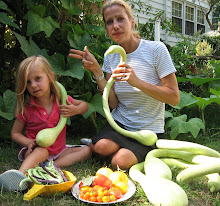She maintains that I don’t enter the right prices in Eco-Nomics. While my method isn’t exactly scientific, I price my produce as I find it in my travels or in my supermarket circular or, to be honest, what I think it might cost as I type away blearily at night and err on the side of caution, on both pricing and weights.
Presented with an offering of fresh basil, a nosegay of chervil, a trio of lemon cucumbers and a mess of purple-podded pole beans, she said, almost salivating, “You have no idea what some people would pay for this.”
Perhaps I am selling a bit short. I could “charge” organic prices in Eco-Nomics for any and all that I harvest. I compost, so that’s natural stewardship of the soil. I don’t use pesticides, fertilizers, Miracle-Gro, sprays – the only thing that touches my plants is rainwater. If my daughter wants to pick and eat her way through the backyard any afternoon, I have no worries, and she’s done so since she was a toddler.
I take my mom to DePiero Farms in Bergen County some Sundays, since it’s also a nice place to walk around, and it charges $3.99/lb for heirloom tomatoes – not designated organic, just heirloom. I also go there in the hopes that I’ll find at least some of the things growing in my backyard for comparable pricing, from purple beans (no dice) to pattypan squash ($10.99/lb for baby pattypans.) That’s unconscionable – and ridiculous! First, I don’t pick mine at the ping-pong ball stage. And even if I did, there’s no way I’d enter that price into Eco-Nomics, because it’s not a price I’m willing to pay. And don’t even get me started on Rhubarb, which is a perennial and comes back for free every year in greater quantities: It costs upwards of $5 a pound, both there and at ShopRite when they have it.
Still, my friend persisted. So I finally headed to Whole Foods in the hopes that it would carry some examples of my produce, which would be organic as well, and I could find out what the store charges and what people are willing to pay for it. I hit the new Fairway for good measure as well.
Holy mackerel.

Organic Heirloom tomatoes cost $4.99 per pound at Whole Foods. The bin was colorful and enticing to be sure, and I gently went through it to see what sorts were represented: There were my Black Russians! And my daughter’s favorite yellows, among gold and green striped (got those, too), white (never grown them), the pale persimmon tomatoes (did those last year – scrumptious) and every shape and wrinkle of red. The skimpy pints of small “Gourmet Medley” tomatoes, at $4.99 each, could have come straight from my backyard as well: lots of orange and red and some purples. For five dollars. Five dollars. And people had them in their carts!
There were no purple beans at Whole Foods or Fairway, but I did find my little haricot verts: pre-packaged from Mexico, $4.99 for a one-pound bag at Whole Paycheck. Organic, yes, but I was somewhat surprised at the measly size of the pound-package. I’m underweighing and under eye-balling mine!
I also could not believe what $2.99 buys you in Swiss Chard: That price per bunch gets you, on average, 8 ½ stalks. I say 8 ½ because those that featured nine stalks had nine that were on the thin side – and I’m being generous in that assessment. Those that contained eight may have had wider stalks, but there were always one or two scraggly stragglers in each bunch, every time. Yes, I stood there counting the contents of twist-tied bunches of both red and white organic chard. You’d fare better at Fairway, with its $1.99/bunch price for at least a somewhat larger bunch of conventional red or white chard.
At least small pattypan squash didn’t cost $10.99/lb – it was “only” $7.99/lb. The butternut squash at both spots was new and fresh, first of the season like mine – but pound for pound, I’m glad I don’t need to buy it!
I had to stop there – or just stop here. I did canvass fully, but couldn’t find specifically what I was growing; only things that were somewhat close. I also must resist rambling on here like my overeager squash and bean vines. Suffice it to say, my friend is kind of right. Plus, I’ve got a potential gold mine back there, and a tasty one at that.




















